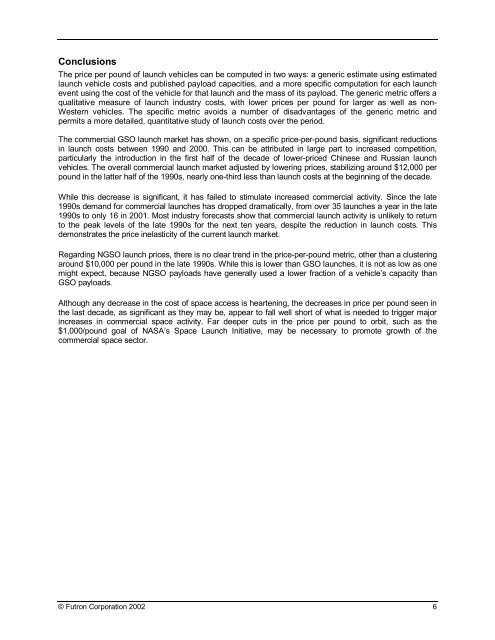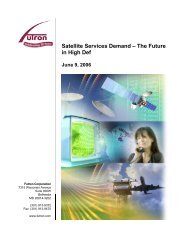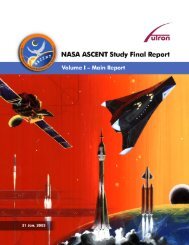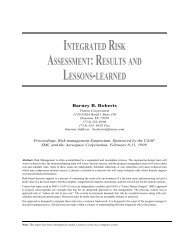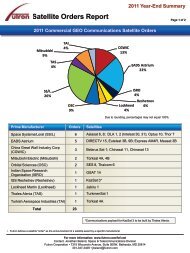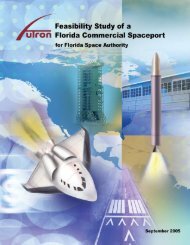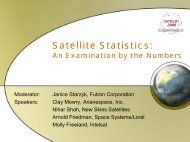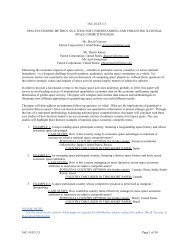Space Transportation Costs: Trends in Price Per Pound to Orbit ...
Space Transportation Costs: Trends in Price Per Pound to Orbit ...
Space Transportation Costs: Trends in Price Per Pound to Orbit ...
You also want an ePaper? Increase the reach of your titles
YUMPU automatically turns print PDFs into web optimized ePapers that Google loves.
Conclusions<br />
The price per pound of launch vehicles can be computed <strong>in</strong> two ways: a generic estimate us<strong>in</strong>g estimated<br />
launch vehicle costs and published payload capacities, and a more specific computation for each launch<br />
event us<strong>in</strong>g the cost of the vehicle for that launch and the mass of its payload. The generic metric offers a<br />
qualitative measure of launch <strong>in</strong>dustry costs, with lower prices per pound for larger as well as non-<br />
Western vehicles. The specific metric avoids a number of disadvantages of the generic metric and<br />
permits a more detailed, quantitative study of launch costs over the period.<br />
The commercial GSO launch market has shown, on a specific price-per-pound basis, significant reductions<br />
<strong>in</strong> launch costs between 1990 and 2000. This can be attributed <strong>in</strong> large part <strong>to</strong> <strong>in</strong>creased competition,<br />
particularly the <strong>in</strong>troduction <strong>in</strong> the first half of the decade of lower-priced Ch<strong>in</strong>ese and Russian launch<br />
vehicles. The overall commercial launch market adjusted by lower<strong>in</strong>g prices, stabiliz<strong>in</strong>g around $12,000 per<br />
pound <strong>in</strong> the latter half of the 1990s, nearly one-third less than launch costs at the beg<strong>in</strong>n<strong>in</strong>g of the decade.<br />
While this decrease is significant, it has failed <strong>to</strong> stimulate <strong>in</strong>creased commercial activity. S<strong>in</strong>ce the late<br />
1990s demand for commercial launches has dropped dramatically, from over 35 launches a year <strong>in</strong> the late<br />
1990s <strong>to</strong> only 16 <strong>in</strong> 2001. Most <strong>in</strong>dustry forecasts show that commercial launch activity is unlikely <strong>to</strong> return<br />
<strong>to</strong> the peak levels of the late 1990s for the next ten years, despite the reduction <strong>in</strong> launch costs. This<br />
demonstrates the price <strong>in</strong>elasticity of the current launch market.<br />
Regard<strong>in</strong>g NGSO launch prices, there is no clear trend <strong>in</strong> the price-per-pound metric, other than a cluster<strong>in</strong>g<br />
around $10,000 per pound <strong>in</strong> the late 1990s. While this is lower than GSO launches, it is not as low as one<br />
might expect, because NGSO payloads have generally used a lower fraction of a vehicle’s capacity than<br />
GSO payloads.<br />
Although any decrease <strong>in</strong> the cost of space access is hearten<strong>in</strong>g, the decreases <strong>in</strong> price per pound seen <strong>in</strong><br />
the last decade, as significant as they may be, appear <strong>to</strong> fall well short of what is needed <strong>to</strong> trigger major<br />
<strong>in</strong>creases <strong>in</strong> commercial space activity. Far deeper cuts <strong>in</strong> the price per pound <strong>to</strong> orbit, such as the<br />
$1,000/pound goal of NASA’s <strong>Space</strong> Launch Initiative, may be necessary <strong>to</strong> promote growth of the<br />
commercial space sec<strong>to</strong>r.<br />
© Futron Corporation 2002 6


